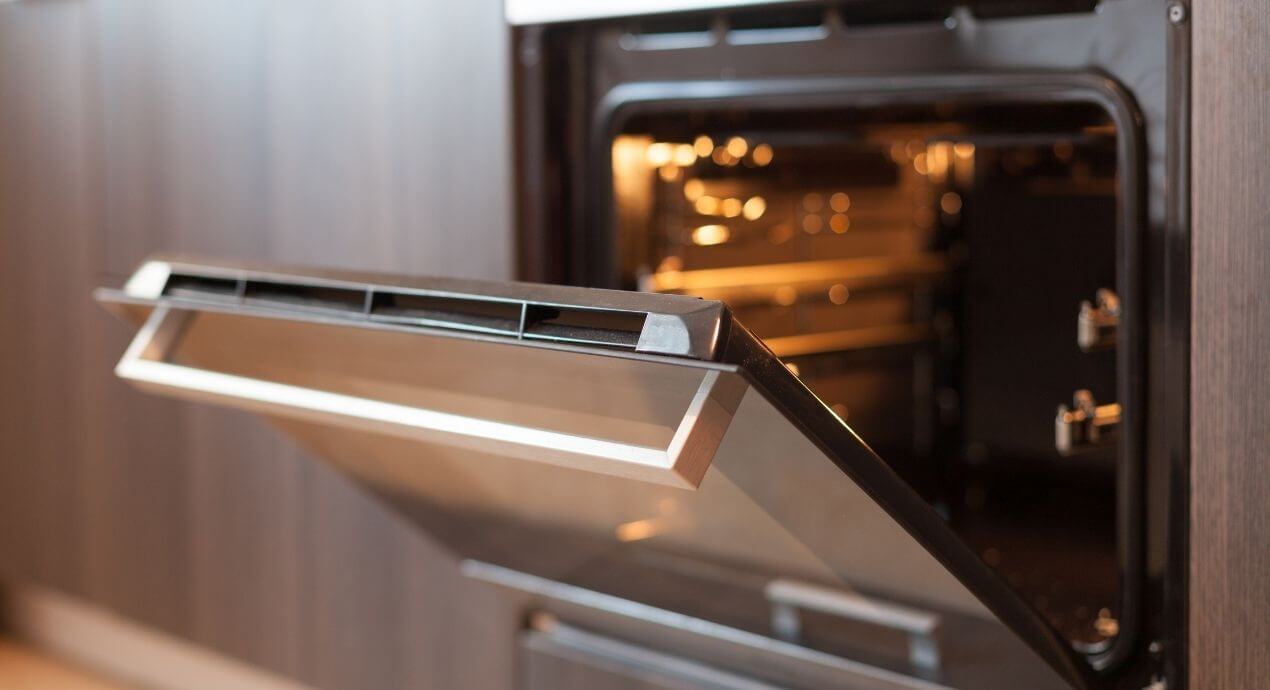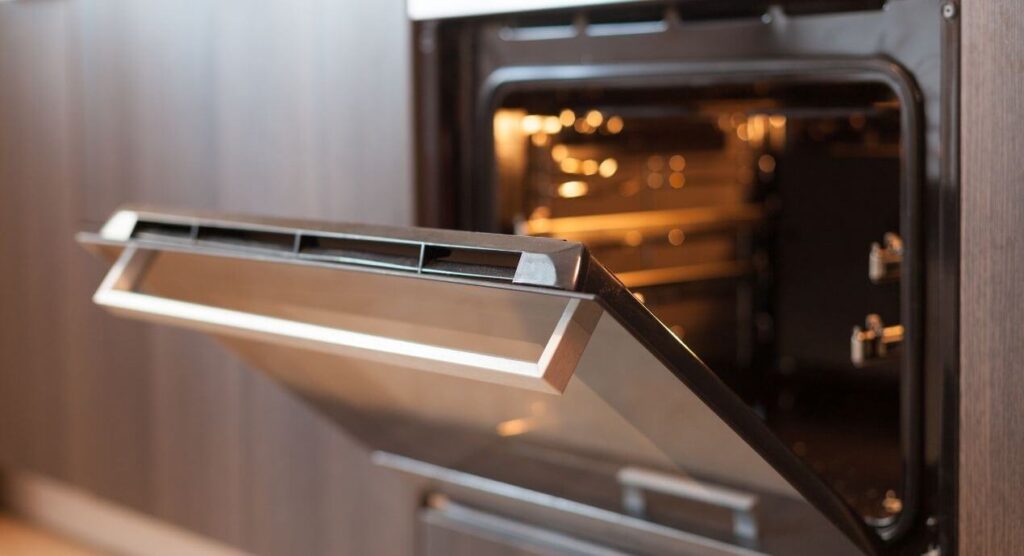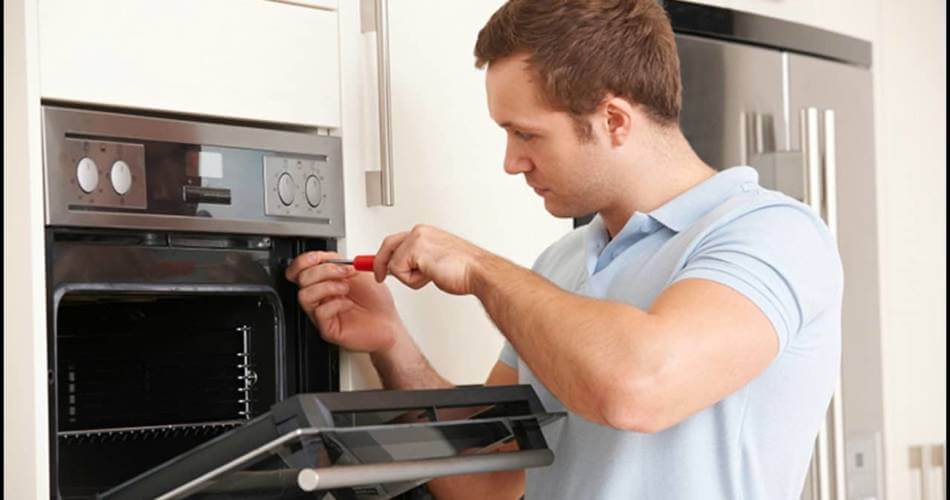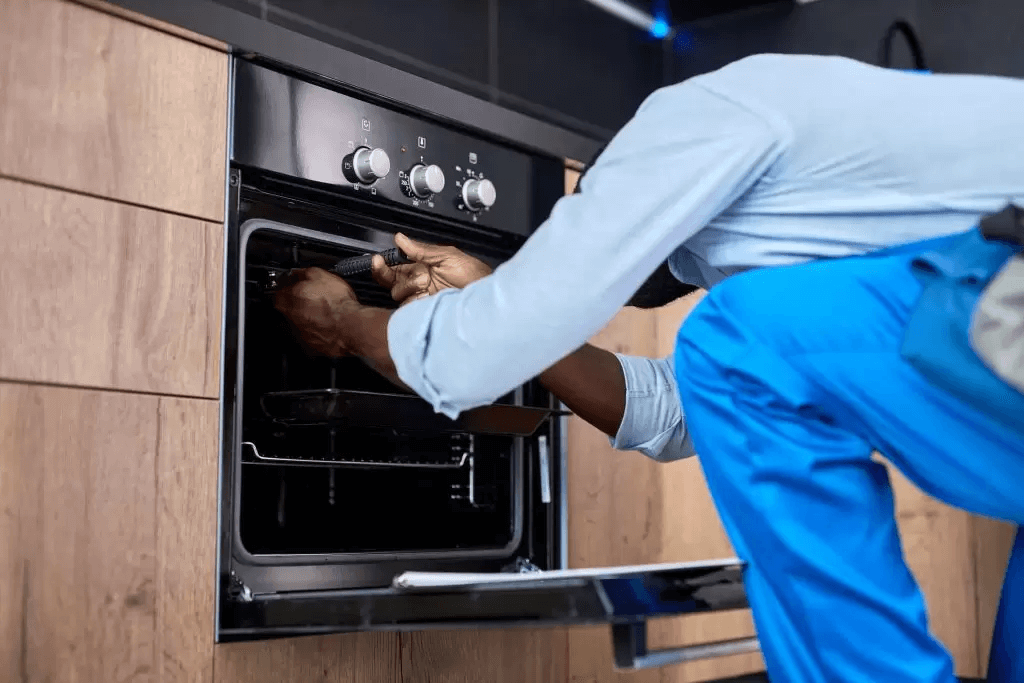

Your trusty oven is a kitchen workhorse, but like any mechanical marvel, it can develop hiccups from time to time. When your oven starts acting up, it can be frustrating, but fret not! We’ve compiled a comprehensive guide to help you troubleshoot and fix common oven problems without the need for costly repairs or replacements. From temperature inconsistencies to peculiar odors, we’ll walk you through the most prevalent oven issues and their solutions.
Oven Won’t Heat Up Properly?
Problem: Your oven’s primary mission is to cook your food evenly and to perfection. When it fails to heat up properly, it can be a real kitchen conundrum. Is your soufflé deflating or your roast not roasting?
Solution: If your oven is not reaching the desired temperature, the issue may lie in its calibration. To test it, acquire an oven thermometer, which can be found at most kitchen supply stores or online. Here’s a step-by-step guide to recalibrate your oven:
- Preheat your oven to a standard temperature, like 350°F (180°C), and give it about 15 minutes to stabilize.
- Place the oven thermometer inside the oven, ensuring it’s not touching any surfaces.
- After 15 minutes, check the thermometer reading. If it doesn’t match the set temperature, it’s time to recalibrate.
Recalibrating your oven will typically involve adjusting its temperature settings according to the difference between the actual and desired temperature. Consult your oven’s user manual for specific recalibration instructions. Keep in mind that this method works best for older ovens; newer models may automatically recalibrate themselves.
Uneven Cooking?
Problem: You’re preparing a sumptuous meal, but your oven decides to play favorites. One side of your lasagna is burnt to a crisp, while the other side remains undercooked.
Solution: Uneven cooking can be a consequence of poor placement or malfunctioning components. Here’s how you can tackle the issue:
- Proper Placement: To ensure even cooking, avoid stacking trays or overloading the oven. Allow enough space between your dishes to allow hot air to circulate freely. Additionally, rotating your dishes during cooking can help promote uniform results.
- Heating Element: If your oven continues to exhibit uneven cooking, there may be an issue with the heating element. This element is responsible for producing heat. Over time, it can weaken or develop hot spots, leading to uneven cooking. Replacing the heating element is a task best left to professionals, as it requires electrical expertise.
- Fan Problems: Many modern ovens come equipped with a convection fan to ensure even heat distribution. If the fan is malfunctioning, it can lead to uneven cooking. Inspect the fan for obstructions or signs of wear and tear. If necessary, contact a technician for repairs.
Oven Smells Like a Campfire?
Problem: You preheat your oven, and suddenly, your kitchen is filled with the aroma of a campfire. Unfortunately, you’re not cooking marshmallows, and this isn’t a pleasant outdoor barbecue.
Solution: The unexpected smoky scent could be attributed to residue or food particles burning on the oven’s floor. To address this issue, follow these steps:
- Turn off the oven and allow it to cool completely.
- Remove any loose debris or charred food remnants.
- Create a cleaning mixture by combining baking soda and water to form a paste. Apply this paste to the interior of your oven, avoiding the heating elements.
- Leave the paste to sit for at least 20 minutes, or until it dries.
- Using a damp cloth or sponge, scrub the interior of the oven to remove the baking soda paste and any stubborn stains.
- Wipe down the oven’s interior with a clean, damp cloth to remove any remaining residue.
This thorough cleaning should eliminate the unpleasant campfire smell and leave your oven fresh and ready for your next culinary adventure.
Oven Door Won’t Close Tight?

Problem: If your oven’s door doesn’t seal properly, it can lead to heat loss and affect your cooking results. A loose door can also pose safety hazards.
Solution: The main components you need to inspect when dealing with a door that won’t close securely are the door gasket and the hinges.
- Door Gasket: The door gasket is a rubber seal that runs along the edges of the oven door. Over time, it can deteriorate or become misshapen, leading to an imperfect seal. Replacing the gasket is a relatively simple task. To do so, follow these steps:
- Order a Replacement Gasket: Ensure you have the correct model and size of gasket for your oven. You can typically find this information in your oven’s user manual or on the manufacturer’s website.
- Remove the Old Gasket: Gently peel off the old gasket from the oven door. You may need to loosen any screws or clips holding it in place.
- Install the New Gasket: Carefully attach the new gasket by following the manufacturer’s instructions. Make sure it’s properly seated and secured.
- Test the Seal: Close the oven door to confirm that it now seals securely.
- Hinges: Loose or damaged door hinges can also lead to a poor door seal. Check the hinges for any signs of wear, damage, or looseness. If necessary, tighten any screws that secure the hinges to the oven. If the hinges are beyond repair, consider replacing them with new ones, which is typically a more complex task best left to professionals.
By addressing door seal issues promptly, you’ll ensure that your oven operates efficiently and safely.
Oven’s Making a Racket?
Problem: Your once-silent oven is now producing a cacophony of squeaks, bangs, and pops. It’s like hosting a rock concert in your kitchen, but you didn’t send out any invitations!
Solution: Unusual noises emanating from your oven can be disconcerting, but there are several potential culprits and corresponding solutions:
- Heating Element: If your oven is producing popping or cracking sounds, it could be due to a faulty heating element. Over time, these elements can develop cracks, leading to unexpected noises. Replacing the heating element should alleviate this issue. Consult your oven’s user manual or seek professional assistance for the replacement process.
- Loose Components: Oven racks, screws, or metal pieces left inside the oven can create rattling or banging sounds during cooking. Inspect the oven’s interior for any loose items and secure them properly to eliminate the noise.
- Fan Issues: The convection fan in some ovens can become noisy due to wear and tear. Inspect the fan for visible obstructions and signs of damage. If necessary, replace the fan or contact a technician to address the issue.
By addressing these common sources of oven noise, you’ll enjoy a quieter and more peaceful cooking experience.
Oven Doesn’t Self-Clean Properly?
Problem: Modern ovens often come equipped with a self-cleaning feature, but what do you do when it doesn’t do the job as expected?
Solution: The self-cleaning feature is designed to incinerate food residue and spills at high temperatures. However, it can be less effective if the oven is excessively dirty or if there’s a problem with the door lock mechanism. Here’s how to resolve self-cleaning issues:
- Clean the Oven Manually: Before initiating the self-cleaning cycle, make sure to manually remove any visible food debris, spills, or large particles from the oven’s interior. Excessive dirt can hinder the self-cleaning process.
- Check the Door Lock Mechanism: If the self-cleaning cycle fails to start or complete, it could be due to a malfunctioning door lock mechanism. The oven’s door must lock during the self-cleaning cycle for safety reasons. Ensure that the door locks securely when the self-cleaning feature is engaged. If not, consult your oven’s user manual or a technician for guidance on resolving this issue.
- Follow Manufacturer Instructions: The self-cleaning process may vary from one oven model to another. Consult your oven’s user manual for specific instructions on how to use the self-cleaning feature effectively.
By following these guidelines and ensuring a clean and well-functioning oven, you can make the most of the self-cleaning feature.
Oven Has Burner Trouble?
Problem: If your oven’s burner isn’t igniting as it should, it can disrupt your cooking plans and lead to undercooked or unevenly cooked dishes.
Solution: Burner issues are typically related to the following components:
- Burner Ports: Burner ports can become clogged or blocked by food debris, spills, or grease. If your burner is struggling to ignite or producing weak flames, it’s essential to clean these ports. Here’s a step-by-step process:
- Turn off the gas supply to the oven.
- Remove the burner element from the oven.
- Inspect the burner ports for blockages. Use a soft brush or a needle to clear any obstructions.
- Reattach the burner element and turn on the gas supply.
- Test the burner to ensure it ignites and produces a consistent flame.
- Igniter Issues: If cleaning the burner ports doesn’t resolve the problem, it may be related to the igniter. The igniter is responsible for lighting the gas. Over time, it can weaken or fail. Replacing the igniter is typically a straightforward task that you can tackle yourself. Consult your oven’s user manual for detailed instructions on replacing the igniter.
By regularly cleaning the burner ports and addressing igniter issues, you can maintain reliable burner performance in your oven.
Oven’s Not Baking Evenly?

Problem: Your oven is supposed to bake your cookies to golden perfection, but it insists on creating a mismatched batch with some cookies underdone and others overcooked.
Solution: Uneven baking is often the result of temperature inconsistencies within the oven. Here’s how you can address this issue:
- Oven Racks: Start by ensuring that your oven racks are correctly positioned. Most ovens have multiple rack slots, allowing you to adjust the rack’s height. Placing your dishes on the appropriate rack can significantly impact baking results. Consult your recipe or oven manual for rack placement recommendations.
- Heating Element: If your oven continues to bake unevenly despite proper rack placement, it may be due to a malfunctioning heating element. The heating element is responsible for producing heat, and over time, it can deteriorate, leading to temperature fluctuations. Replacing the heating element is a more advanced DIY task, but it can resolve the issue. Refer to your oven’s user manual for specific replacement instructions.
- Convection Feature: Some ovens feature a convection setting, which uses a fan to circulate hot air, resulting in more even baking. If your oven has this feature, consider using it to improve baking uniformity.
By addressing these factors, you’ll be well on your way to achieving consistent and evenly baked culinary creations.
Final Words
Your oven is a vital kitchen appliance, and understanding how to troubleshoot common issues can save you both time and money. By following the solutions provided in this comprehensive guide, you can tackle a wide range of common oven problems, from uneven cooking to unexpected noises and self-cleaning dilemmas. Remember that regular maintenance and care are key to ensuring your oven operates at its best.
So, the next time your oven starts acting up, don’t panic. Instead, roll up your sleeves, consult this guide, and put your DIY skills to the test. With a little effort and the right know-how, you can keep your oven in top shape and enjoy consistent cooking results in your kitchen. Happy cooking!
Frequently Asked Questions (FAQ) About Common Oven Problems and Solutions
Welcome to the Frequently Asked Questions section of our comprehensive guide on common oven problems and their solutions. Here, we address some of the most common queries and concerns related to oven issues and how to fix them.
1. Why is my oven not heating up properly, and how can I fix it?
Answer: If your oven is not heating up as it should, it may require recalibration. Start by using an oven thermometer to check the accuracy of your oven’s temperature. If it’s off, consult your oven’s user manual for specific recalibration instructions. This process typically involves adjusting the temperature settings to align with the actual temperature.
2. How can I resolve issues with uneven cooking in my oven?
Answer: Uneven cooking can often be resolved by ensuring proper placement of your dishes within the oven. Avoid overcrowding and use the appropriate rack positions as recommended by your recipe or oven manual. If the issue persists, it may be related to a malfunctioning heating element or fan, which should be inspected and replaced by a professional.
3. What should I do if my oven emits a strange campfire-like smell?
Answer: A campfire-like smell may indicate burnt food residue on the oven’s floor. To address this, turn off the oven, let it cool, and then remove any loose debris or spills. Create a baking soda and water paste, apply it to the interior, and scrub away the grime. Wipe the oven clean, and the unpleasant odor should dissipate.
4. How can I fix an oven door that doesn’t close tightly?
Answer: An oven door that doesn’t close securely may be due to a worn-out door gasket or loose hinges. You can replace the gasket by following specific instructions found in your oven’s user manual. If the hinges are problematic, consider tightening any screws holding them in place or consult a professional for a thorough inspection and possible replacement.
5. What should I do if my oven starts making unusual noises?
Answer: Unusual noises in your oven can be attributed to various causes. If you hear popping or cracking sounds, it may be due to a faulty heating element, which should be replaced. Loose components within the oven, such as racks or screws, can create rattling or banging sounds, and you should secure them properly. Additionally, a malfunctioning fan can cause noise, and it may need to be inspected and repaired by a technician.
6. How can I troubleshoot issues with my oven’s self-cleaning feature?
Answer: If your oven’s self-cleaning feature is not working effectively, start by manually removing visible food debris and spills from the oven’s interior. Ensure that the door locks securely during the self-cleaning cycle, as a malfunctioning door lock mechanism can hinder the process. Consult your oven’s user manual for specific instructions on using the self-cleaning feature.
7. What steps can I take to address burner problems in my oven?
Answer: Burner problems are often related to clogged or blocked burner ports. Turn off the gas supply and remove the burner element. Inspect the ports for obstructions, and use a soft brush or needle to clear them. If the issue persists, consider replacing the igniter, which is responsible for lighting the gas. Follow your oven’s user manual for guidance on replacing the igniter.
8. How can I resolve issues with uneven baking in my oven?
Answer: Uneven baking can result from various factors. Start by ensuring that your oven racks are correctly positioned and use the recommended rack slots for your dishes. If the issue persists, inspect the heating element, as it may be malfunctioning and require replacement. Consider using the convection feature, if available, to improve baking uniformity.
